[key_takeaways title="Steps to begin getting paid in Tether (USDT):"]
- Choose a platform: Select a trustworthy platform that supports USDT. Create and verify an account if needed.
- Create a wallet: Create a crypto wallet and make a note of your private key.
- Send wallet details: Send your wallet address to your employer. Double-check it to ensure the network and address are correct.
- Get paid in USDT: You can now get paid in USDT. You'll be able to receive Tether, which can be sold for fiat or used to cover spending.
[/key_takeaways]
Learning how to get paid in USDT can be confusing. There are many methods, but only a few are worth using.
We provide a step-by-step breakdown of getting paid in USDT, highlight different methods, discuss the risks, and explain what to consider beforehand. Let's get started.
Why do people want to be paid in Tether (USDT)?
People want to learn how to get paid in USDT to gain control over their finances.
USDT is ideal for people working with international companies as it lets you consolidate income in one place, has a stable value, and can be sent across borders in seconds without delays or excessive costs.
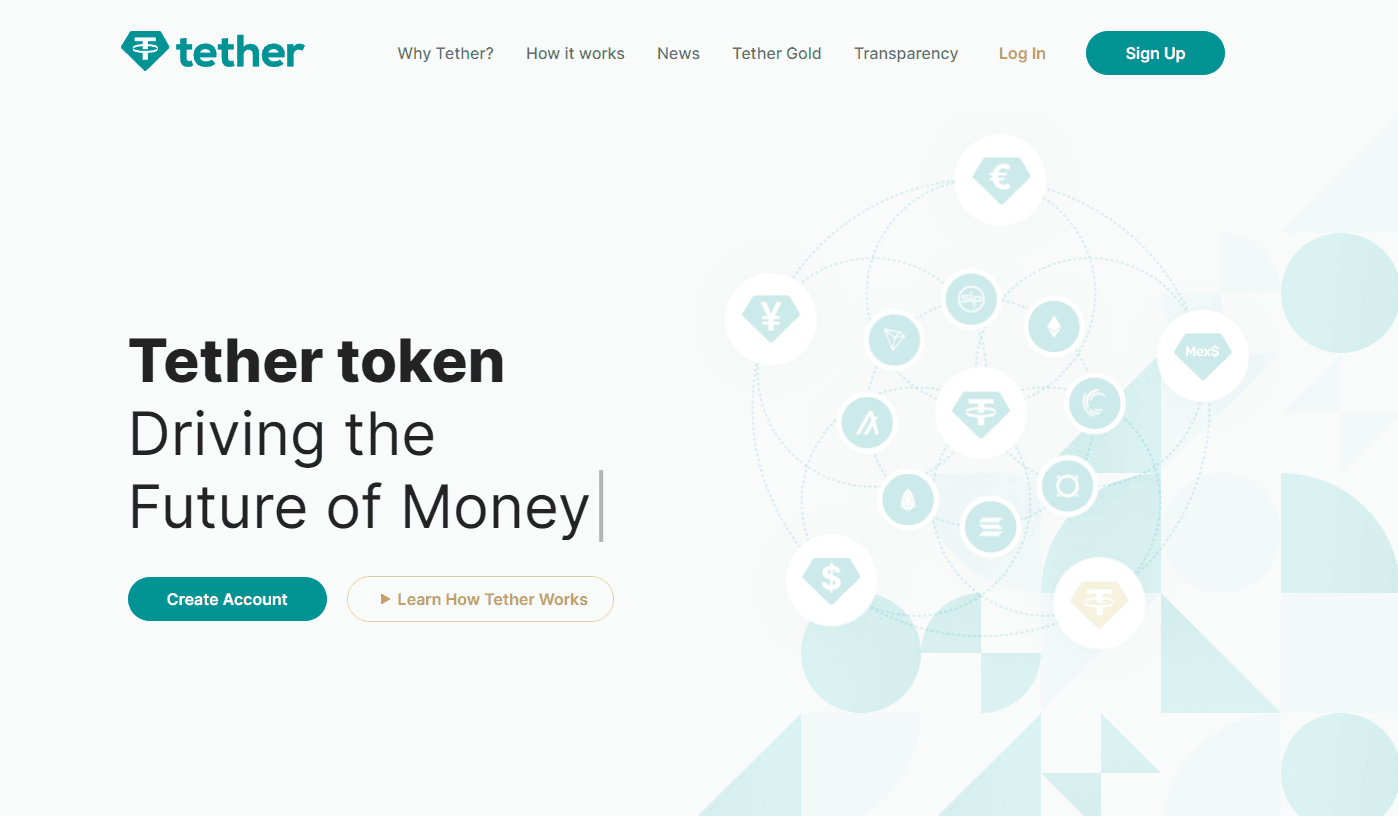
What are the different ways to be paid in Tether (USDT)?
The most common method is getting paid directly to a crypto wallet. However, you can also accept payments on dedicated invoicing platforms or a trading platform that enables you to exchange crypto for fiat easily.
Before choosing a way to be paid, you should talk to your employer. The accounting team could have an existing system for sending or prefer a specific method.
Discussing things with your employer can feel daunting, but keeping communication open is critical to finding a mutually beneficial agreement.

How to get paid in USDT for beginners
Although it can feel like a significant hurdle, the process is simple if you're wondering how to get paid in USDT. To begin getting paid in Tether, follow these steps:
Step 1: Choose a crypto wallet
You need to select one of the best Tether (USDT) wallets and check that it matches your requirements. You should ensure that it supports your chosen network (usually Ethereum) and has a good track record.
Step 2: Create a crypto wallet
Create your crypto wallet by opening an account on an exchange and completing the verification process or using a non-custodial wallet and confirming/storing your private key.
Your private key recovers the wallet and should be stored offline.
Step 3: Send an invoice or review your pay slip
Once you and your employer have agreed on USDT payments, you must issue an invoice containing your crypto wallet address. Alternatively, you should review your pay slip to ensure it shows the correct address.
Step 4: Receive Tether payments
Depending on the fee and network congestion, the payment can take a couple of minutes to a few hours to confirm.
If you have the transaction ID, review the transfer using EtherScan to check its remaining confirmations.
A better way to get paid in Tether (USDT) - Discover swissmoney
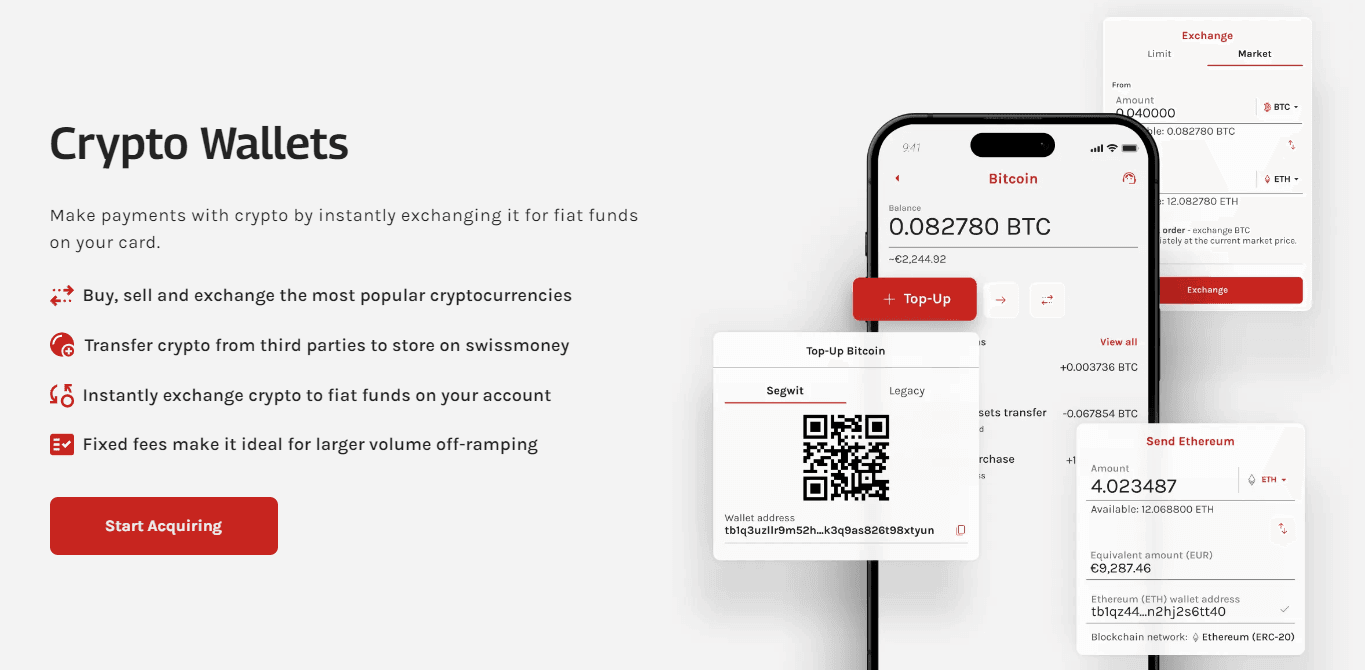
If you want to get paid in USDT to a platform supporting crypto-to-fiat conversions without using an exchange, financial services provider swissmoney could be perfect.
The FINMA-regulated platform lets you receive USDT payments while giving you the tools to withdraw to a bank account or spend crypto anywhere.
- Crypto wallet: All swissmoney users have a crypto wallet that they can use to store USDT and other coins like Bitcoin.
- Crypto debit card: Unlike other platforms, swissmoney offers users a crypto debit card they can fund with USDT and use anywhere Visa or Mastercard is accepted.
- Exchange crypto: swissmoney lets you buy, sell, exchange, and off-ramp crypto, making the platform an excellent all-around option.
- Dedicated IBAN account: swissmoney users can open dedicated GBP, USD, EUR, and CHF IBAN accounts to send cross-border transfers and pay direct debits without an external platform.
How to set up a wallet to receive USDT on swissmoney
While setting up a crypto wallet and an exchange account can be time-consuming and tricky, swissmoney makes getting set up to receive pay in USDT simple.
You can create a USDT wallet on swissmoney by completing the following steps:
Step 1: Create and verify a swissmoney account
On the swissmoney app, tap one of the 'Continue with Google/Apple/Email' buttons, press 'Sign up,' select either a personal or business account, and input your name, email, and password.
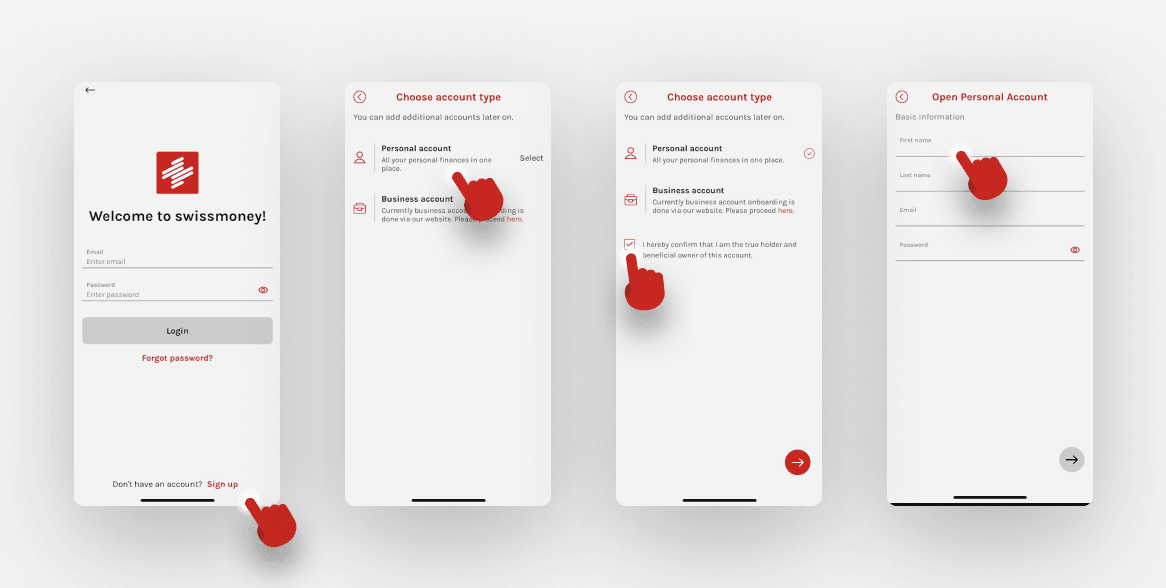
Then, complete verification by confirming your address, taking a picture of a photo ID, and answering a few questions.
Step 2: Add USDT wallet to swissmoney
From the home screen, tap 'Digital assets', press 'Add new,' choose 'Tether,' and press the 'Add' button.
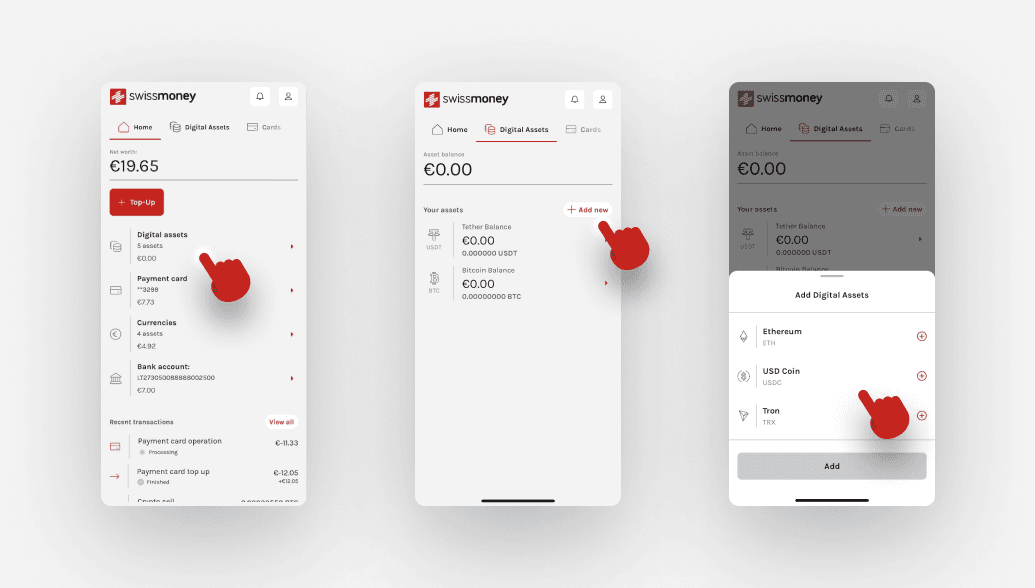
You can verify that your USDT wallet has been added by checking the 'Digital Assets' screen. You can also add other digital currencies as needed.
Step 3: Recieve USDT payments
To begin receiving USDT payments, you must send your wallet address to your employer.
From the 'Digital Assets' screen, click 'Tether Balance,' choose 'Receive,' then tap the red paper icon to copy the wallet address.
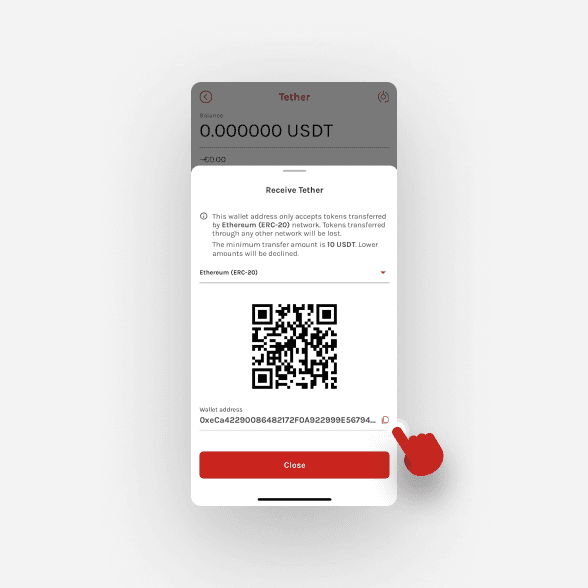
Once your employer has the wallet address, they have the necessary details to pay you in USDT.
What are the pros and cons of being paid in USDT?
Before you decide to get paid in USDT, you should consider the pros and cons. We've highlighted some of the most critical factors.
| Pros | Cons |
| Ideal for cross-border transactions | Requires ETH to cover gas fees |
| USDT is easy to invest | Initially more complicated than a bank |
| Immutable payments | Difficulty managing payments |
Pros:
- USDT payments are decentralized, so they're perfect for cross-border transactions where banks would charge hefty fees.
- Crypto exchanges denominate many cryptocurrency pairs in USDT, so it's easy to use the stablecoin to fund investments.
- USDT transactions are immutable and can be viewed on EtherScan, eliminating payment disputes.
Cons:
- You'll need to buy some Ethereum to cover gas fees, which typically range from $3 to $20.
- The entire process can feel complex and inconvenient if you haven't been paid in USDT before.
- It can be difficult to manage payments if you're unfamiliar with using a crypto wallet.
What you need to know before you get paid in USDT
Before rushing ahead and getting paid in USDT, there are a few factors to consider beforehand.
Gas fees
Gas fees are easy to overlook but can quickly eat into your earnings. Gas is paid in ETH. USDT payments are slightly more expensive than standard Ethereum transactions, usually costing around $7 to $10.
Suitable for you
Getting paid in USDT isn't always the best option. It can involve heavy fees and make managing money difficult. However, if you work internationally or frequently invest in crypto, it could offer more convenience.
Cash-out method
If you're getting paid in USDT, you'll need a way to cash out to fiat; otherwise, you could struggle to pay for certain things like shopping or rent. Therefore, you need to have a cash-out method ahead of time.

Is it safe to get paid in USDT?
An important consideration when receiving income in USDT is safety. Many consider the crypto market unsafe, and with over $24 billion sent to illicit addresses in 2023, it's easy to see why.
However, getting paid in USDT is safe if you follow cryptocurrency security protocols. You can protect yourself in critical areas by using unique passwords, setting up two-factor Authentication (2FA), and only accessing platforms via bookmarks.
What are the risks of getting paid in USDT?
While getting paid in USDT is safe, there are a few risks to be aware of. That said, the most significant danger of getting paid in USDT is human error, which is avoidable.
Incorrect payment details
Recovering crypto payments sent to the wrong address or using an incorrect network is impossible.
As such, you must always double-check the payment details when preparing an invoice or sending it to your employer.
Tax issues
While most countries treat crypto earned via employment as income, some regulators have archaic cryptocurrency rules. If you don't take the time to read up on your local regulations, you could end up receiving a fine.

What tax do I pay when getting paid in USDT?
Your earnings are subject to standard income tax if you receive USDT as income from a job. Capital gains taxes are usually only levied against profits earned from investments.
However, if you use USDT income to invest, you'll still have to pay capital gains tax on any profits.
Cryptocurrency market tax regulations vary significantly between countries. Always familiarize yourself with your local laws before you accept Tether payments.
Conclusion
After reading our guide, you know exactly how to get paid in USDT, different payment methods, tax implications of earning income in USDT, the pros/cons of Tether payments, and the best platforms for receiving USDT payments.
However, we found one platform yielding greater convenience than the rest.
swissmoney lets people receive USDT payments and offers the tools to exchange the stablecoin for another crypto or sell it for fiat that you can withdraw.
Moreover, users can access a crypto-funded debit card and IBAN accounts, making cashing our USDT simple and seamless.
FAQs
How to earn money with USDT?
Once you have your USDT secure in a crypto wallet, you can send the asset to a cryptocurrency exchange for trading, use it as a store of value, or earn up to 18% interest on your holdings via crypto staking.
How do I receive USDT payments?
Before accepting USDT payments, you must create a crypto wallet like MetaMask or buy a hardware wallet like a Ledger. Then, an employer or client can use your wallet address to transfer USDT to you.
Where can I get paid in USDT?
If your employer can conduct a crypto transfer, you can get paid in USDT directly to a crypto wallet or swissmoney account.
However, if you want to send an invoice using fiat and get paid in crypto, you can use a platform like Request.
Is getting paid in USDT legal?
Receiving earnings using a Tether payment method is perfectly legal.
While you must ensure that you declare and pay the correct taxes for your country and income, nothing prohibits you from being paid using the stablecoin.
Is it worth getting paid in USDT?
Consider the implications before deciding if using a Tether payment gateway is worth it. You'll need Ethereum to cover network costs and a way to off-ramp crypto to a bank account.
However, USDT is ideal for people working with international clients as it's not affected by cross-border regulations.
Should I invest in USDT before using it to get paid?
USDT is a stablecoin linked to the value of the US dollar. Unless you want USD exposure, there is no reason to invest in the asset before using it to receive income.
How do I get cash from USDT?
You must convert Tether to a local fiat currency, and then you can withdraw it to a bank account and use an ATM to get cash.
Alternatively, you could use a platform like swissmoney, which offers a debit card that can be topped up using crypto.
How can I convert USDT to fiat currency?
To convert USDT to fiat, you must transfer the stablecoin to a platform like swissmoney or Coinbase, which offers crypto-to-fiat conversions. Then, sell the USDT for a fiat currency of your choice.
Further Reading
- How to Withdraw USDT to a Bank Account
- How to Pay With Tether (USDT)
- How to Send Tether (USDT) Between Wallets
- How to Convert USDT to USD
- How to Create a USDT TRC20 Wallet
- How To Buy Tether (USDT) Instantly
- How to Receive USDT
- How to Get Paid in Bitcoin and Other Crypto
- How to Get Paid in Ethereum
- How to Get Paid in USDC

